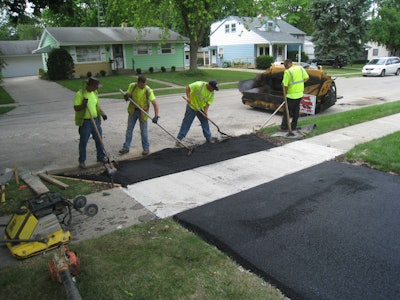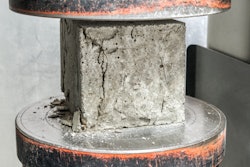
Even the most basic of tools can affect the success – or failure – of a paving operation. Take for instance the “boring” shovel. Every paving crew has at least one, most have multiple shovels, not everyone uses them correctly, and few people treat them with the care they require.
There are three different types of shovels, and which you use depends partly on personal preference but also on the region in which you work.
In the Northeast pavers generally use long-handled shovels with smaller buckets or square, pointed buckets. Handles are generally 5-ft. long and buckets are 2 ft., so they can hold quite a bit of mix.
In the South you’ll find a lot of short-handled shovels with handles much like handles on a coal or snow shovel. These shovels feature 4-ft.-long handles and buckets that are 1-1/2 ft., so they hold less mix than the shovels found in the Northeast. These short-handle shovels require the user to bend down more because of the shorter handle, but they also give the user more power when they have to throw it more control over casting material. Shorter handles make it easier to control the spray of material.
In the Midwest (and I’ve found in Hawaii too) they use short-handle shovels with big buckets that can hold up to three times the amount of material. People who use these shovels “really get into it.” They are heavier to use but they bite into the mix a little easier. Because they hold more mix they are heavier but they require fewer shovels full to get the job done.
How and Why to Keep Shovels Clean
As with any tool, you need to maintain shovels and keep them clean if you want to get the best use from them. So make sure to clean and lubricate all shovels so that when you dig in you can dig smoothly and can get a good shovel full.
When your shovel is clean and lubricated it’s easier to empty the shovel of material and have it go where you want it to go. If the shovel is clean the mix will slide off nicely, but if the shovel is not clean with clogs of mix stuck to the bucket, the clogs will get in the way of your tossing the mix where you want it.
So make sure to clean and lubricate both the back and front side of the shovel bucket. It helps to carry a putty knife with you in a sheath to scrape the bucket clean. It also helps if you keep the shovel bucket hot by sticking it into the hot mix asphalt in the hopper – this makes it easier for the shovel to bite into the mix when you’re getting a shovel full and also eases dumping the material. The mix will slide easily off the shovel and won’t spray all over the place because it’s not stuck to the bucket. If the shovel isn’t clean and lubricated the mix will often just drop off it as a blob or a pancake instead of scattering as it’s supposed to.
The Shovel on the Job
So when working on a paving crew, what is the role of the shovel? It’s to fill any holes or depressions in the mat. So you’re getting a shovel of mix from the hopper to place or scatter on the mat.
But how much should your shovel hold? Regardless of which type of shovel you use or how big the bucket is, it’s essential to look at the size of the hole or depression before going to the paver and getting a shovel full of mix. If you need only half a shovel full of mix there’s no reason to bring a full shovel of mix – it not only wears down the laborer who is carrying more mix than needed but that extra material will just be wasted and have to be taken away by the lute man.
Material Casting Tip
Most people don’t realize it but who wields the shovel can impact the quality of the job.
Assume two people are operating the paver, one on the left and one on the right (standard operating procedure). What often happens when mix is needed on the right side the operator on the left side will get a shovel full and cast or toss it over on the right side where he’s told it’s needed.
But what should happen is the person on the side where the mix is needed should get the material and place or cast it on his own side. Why? Because if the operator on the other side casts the mix across the mat to where it’s needed the fines sit and the stone rolls right out and it looks like a mess. You don’t get the amount of mix where you really need it, so all you’ve done is created work and not improved the mat or solved the mat problem.
John S. Ball is president of Top-Quality Paving, P.O. Box 4398, Manchester, NH 03104; [email protected]. He is also an annual speaker at National Pavement Expo, which will be held Feb. 7-10, 2018 in Cleveland. For details on John’s sessions visit www.nationalpavementexpo.com starting in July.




















